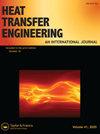太阳静压中小通道与大通道流动沸腾特性的比较
IF 1.6
4区 工程技术
Q3 ENGINEERING, MECHANICAL
引用次数: 0
摘要
摘要在不同热流密度(1kw /m2 ~ 2kw /m2)和流体质量流密度(20g /s ~ 40g /s)条件下,对矩形小通道的热工性能进行了估计。采用混合流模型计算了微宏通道内的两相流动特性。本研究的重点是确定小通道(< 3mm)和大通道(> 3mm)内蒸汽组分增强的主要因素。利用温差(壁侧和水膜侧)、摩擦系数、努塞尔数、蒸发薄膜厚度、换热系数和汽分等参数解释了流体的流动特性。仿真结果与前人的研究结果吻合较好。小通道和大通道的摩擦系数值分别为0.0004和0.0011。研究发现,与小通道相比,大通道管道的换热量要大得多。通过量纲分析,首次建立了蒸汽馏分与通道直径、流体质量、流量和热流密度等相关参数的经验关联关系。预测的汽分与膜厚的相关性有助于理解通道直径对传热的显著影响。免责声明作为对作者和研究人员的服务,我们提供了这个版本的已接受的手稿(AM)。在最终出版版本记录(VoR)之前,将对该手稿进行编辑、排版和审查。在制作和印前,可能会发现可能影响内容的错误,所有适用于期刊的法律免责声明也与这些版本有关。本文作者Thavamani Jayaraj是泰米尔纳德邦金奈Kattankulathur SRM科学技术研究所机械工程系的助理教授。印度。他于2009年获得安娜大学制冷与空调工程硕士学位。他正在攻读太阳能蒸馏系统影响参数的博士学位。在过去的13年里,他一直在传热和制冷系统领域工作。Pankaj Kumar是泰米尔纳德邦金奈卡坦库拉图尔SRM科学技术研究所机械工程系的研究助理教授。印度。在过去的十年里,他一直从事两相流和传热领域的研究。他在国际期刊上发表了16篇以上的研究论文,主要集中在空化、两相流和圆柱流方面。本文章由计算机程序翻译,如有差异,请以英文原文为准。
Comparison of flow boiling characteristics between minichannel and macrochannel in solar still-numerical study
ABSTRACTThe thermal performance of a rectangular minichannel has been estimated for various heat fluxes (1 kW/m2 to 2 kW/m2) and fluid mass flux rates (20 g/s to 40 g/s). The mixture model is used to determine two-phase flow characteristics in the mini-macro channel. The focus of the present work is to establish prime factors for the enhancement of vapour fractions inside the minichannel (< 3 mm) and macrochannel (> 3 mm). The fluid flow characteristics are explained with help of temperature difference (the wall side and water film side), friction factor, Nusselt number, evaporative thin film thickness, heat transfer coefficient and vapour fraction. Validation of current simulation with earlier research article shows good agreement. The friction factor value for the minichannel and macrochannel are 0.0004 and 0.0011, respectively. It is found that heat transfer is significantly more in macrochannel pipes compared with minichannels. By using the dimensional analysis, empirical correlation is developed for vapour fraction with dependent parameters such as channel diameter, fluid mass flow rate and heat flux the first time. The predicted correlation of vapour fraction and film thickness help to understand the pronounced effect of channel diameter on heat transfer.DisclaimerAs a service to authors and researchers we are providing this version of an accepted manuscript (AM). Copyediting, typesetting, and review of the resulting proofs will be undertaken on this manuscript before final publication of the Version of Record (VoR). During production and pre-press, errors may be discovered which could affect the content, and all legal disclaimers that apply to the journal relate to these versions also. Additional informationNotes on contributorsThavamani Jayaraj Thavamani Jeyaraj is an Assistant Professor at the Department of Mechanical Engineering, SRM Institute of Science and Technology, Kattankulathur, Chennai, Tamilnadu. India. He obtained his Master of Engineering in Refrigeration and Air conditioning from Anna University in 2009. He is doing Doctorate in the area of influence parameter of solar distillation system. For the past 13 years he has been working in the heat transfer and refrigeration system field.Pankaj Kumar Pankaj Kumar is a Research Assistant Professor at the Department of Mechanical Engineering, SRM Institute of Science and Technology, Kattankulathur, Chennai, Tamilnadu. India. He has been working in the field of two-phase flow and heat transfer for the past 10 years. He has published more than 16 research papers in international journals focusing on cavitation, two phase flow, and flow past a circular cylinder.
求助全文
通过发布文献求助,成功后即可免费获取论文全文。
去求助
来源期刊

Heat Transfer Engineering
工程技术-工程:机械
CiteScore
4.50
自引率
17.40%
发文量
111
审稿时长
7.5 months
期刊介绍:
Publishing 18 issues per year, Heat Transfer Engineering is an unparalleled resource for key advances in the field of heat transfer for the practicing engineer and other workers in the field. The journal publishes analytical, numerical, and experimental articles of lasting interest in the general area of heat-mass transfer and the related fluid mechanics and thermodynamics.
In a clear, easy-to-read format, the journal includes refereed papers of original work, state-of-the-art reviews, articles on new developments in equipment or practices, reviews of fundamentals, heat in history articles, book reviews, news items on people and companies in the field, advertising, and any other items that may be appropriate.
All submitted manuscripts are subject to initial appraisal by the Editor and/or selected members of the Editorial Board, and, if found suitable for further consideration, to peer review by independent, anonymous expert referees.
 求助内容:
求助内容: 应助结果提醒方式:
应助结果提醒方式:


